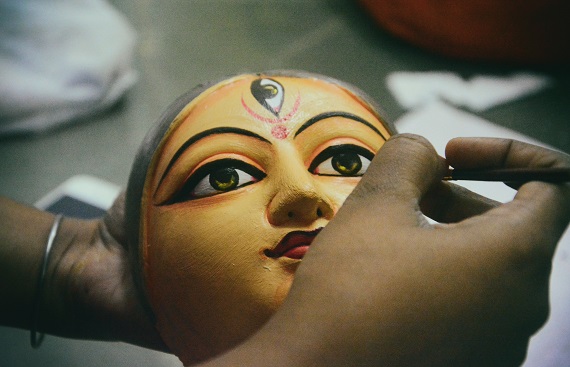October in India: The Month of Divine Feminine

Every year, nature exhibits the ultimate show as the leaves change color. It is in October where the travel and festival season begins to kick off in earnest. The month witnesses shoulder season with reasonably comfortable temperatures and lots of post-rain greenery. Moreover, festivals inevitably lead to two situations: fun and energetic days.
Navrati, as a significant festival of the month and in Hinduism, is held in honor of the divine feminine. People from all over the country celebrate the auspicious festival with great devotion. Navratri means nine nights and is also known as Sharad Navratri. It happens over nine days during the month of Ashvin, or Ashvina (in the Gregorian calendar, usually September–October). The tenth day is the celebration of Dussehra, also famous as Vijayadashami. It is the end of Navratri. In some parts of India, Dussehra has recognized a focal point of the festival, making it effectively span ten days instead of nine.
Cultural beliefs & traditional practices of Navratri/Durga Puja/Dussehra
The celebrations vary across regions, as per local customs and traditions, but the main theme of the festival is the victory of good over evil. Let’s explore the different states and have a look at the way Navratri.
West Bengal
![]()
West Bengal, the second-largest tea-producing state in India, is home to the globally acclaimed Darjeeling tea variety. Generally, people visit the state for its colonial-era monuments, temples, hill stations, cuisine, beaches, wildlife, trekking, jungle safari, sightseeing, spirituality, Toy Train, arts & crafts, heritage, and culture. Bengalis have long fostered art, literature, music, and drama. The visual arts have, by tradition, been based chiefly on clay modeling, terra-cotta work, and decorative painting.
The celebration of Navratri depicts art and culture. Navratri is celebrated as ‘Pujo’ in West Bengal. Navratri of the state is renowned for ‘Pandals’ are built in every nook and corner with different themes every year. Unique images and idols of Durga commemorating her supremacy over the buffalo-headed demon Mahishasura are worshiped daily. On the 10th day (Dussehra), they are taken in jubilant processions to nearby rivers or reservoirs for immersion in water.
Bihar and Jharkhand
Well, Bihar is known as one of the most sacred places of various religions like Hinduism, Buddhism, Jainism, Sikhism & Islam. Many tourists travel to Bihar to visit their pilgrimage. Mahabodhi Temple, a Buddhist shrine and UNESCO World Heritage Site, is also situated in Bodh Gaya.
The Land of Forests', as Jharkhand is famously identified, is heaven for nature lovers. The exceptional beauty of the state with majestic hills, scenic waterfalls, rich greenery, and colorful culture makes your visit to the land memorable. The credit goes to the dominant tribal population; the land conserves nature at its best.
In both states, the Navratri celebration has glimpses of Bengal. Mahishasur Mardini Maa Durga is located in Pandals. Here Devi is acknowledged as the goddess of Shakti and Tantra. Practices to remove hostile powers from the houses are also performed. And a ritual of 'Kalash Sthapana' and keep fast are followed in every house.
PunjabSwathes of lush green wheat fields, charming countryside villages dotted with fields of yellow mustard flowers, and beautiful, nourishing five rivers, Punjab is India’s most fertile and beautiful state. The state is harmonious with different religions growing alongside each other, celebrating life, and enjoying a good taste in food and drink. Anyone can encounter this ‘Punjabiness’ in Amritsar, Chandigarh, Ludhiana, Jalandhar, Patiala, and Bhatinda. The shimmering illustration of the Golden Temple is the most representative visual of Punjab and Sikhism.
In Punjab, the Navratri would be Navratri Kirtan of Singh Vahini Maa Durga, and Jagrata is done at night. There is a ritual and tradition of fasting in the initial seven days, while on the eighth and ninth day; nine girls are worshiped, known as Kanjika.
Gujarat
![]()
Popularly known for the dream city Mumbai, Maharashtra is probably the most diverse as well as balanced states in India. It is home to a number of beaches that are definitely worth a visit. Kashid, Ganpatiplue, Alibaug, Tarkarli, Dapoli and Harihareshwar are a few beaches that simply add up to the faultless beauty of this state. Even though the most famous festival of the state is Ganesh Chaturthi, still people of the state celebrate Navratri as Dussehra. People light ‘Akhand Jyoti’ in their homes on this occasion and keep it lit for nine days constantly. On Dussehra, the males of the house worship their cars, tools etc.
North Indian StatesDussehra is related to the victory of the god Rama over the demon-king Ravana. The Ram Leela ("Play of Rama") is the festival's spotlight in northern India. On successive nights different episodes of the epic poem, the Ramayana are dramatized by young actors elaborately costumed and masked; the pageant is always climaxed by the burning of monumental effigies of the demons, which is known as 'Ravan Dahan'
South Indian States


.jpg)
.jpg)
